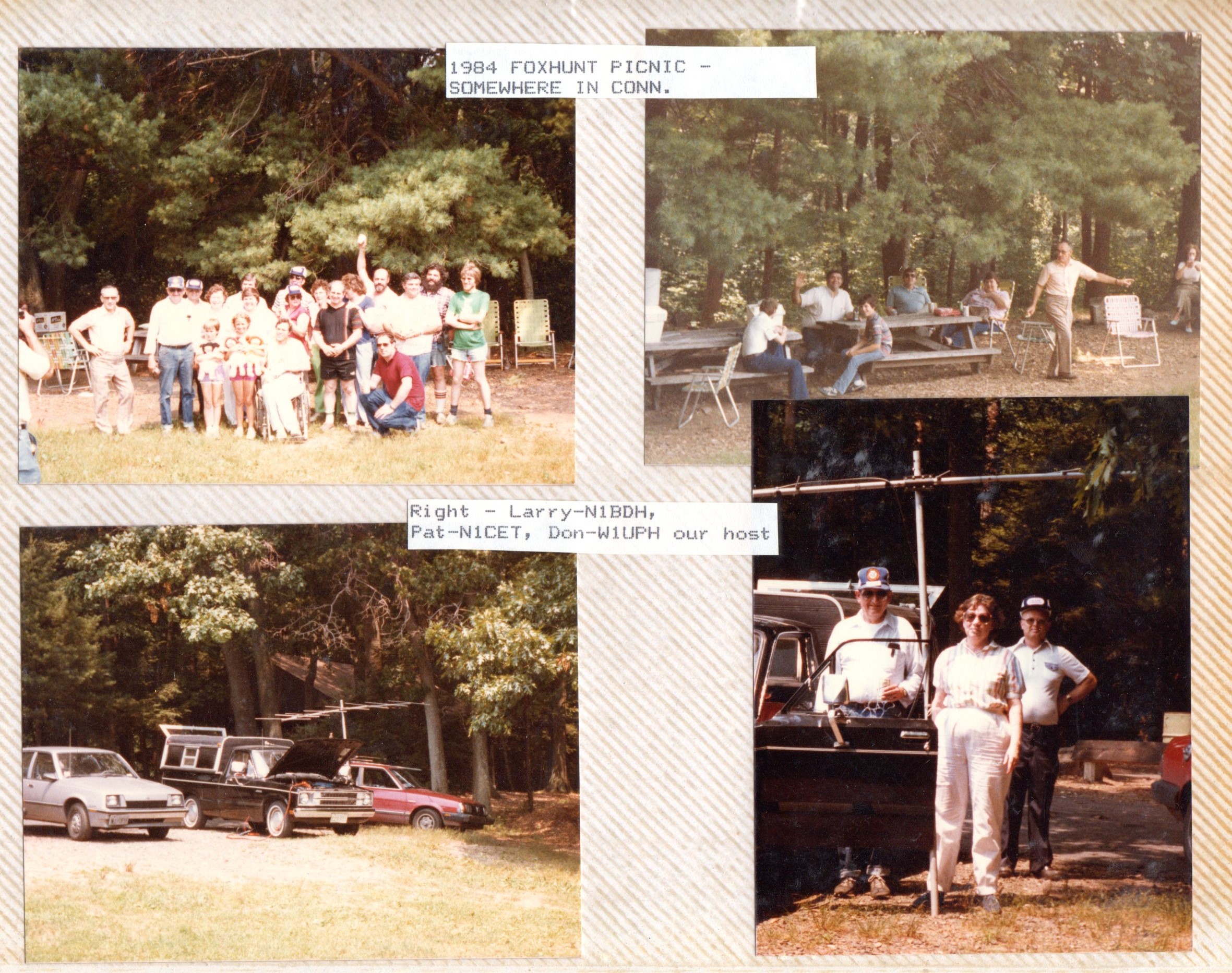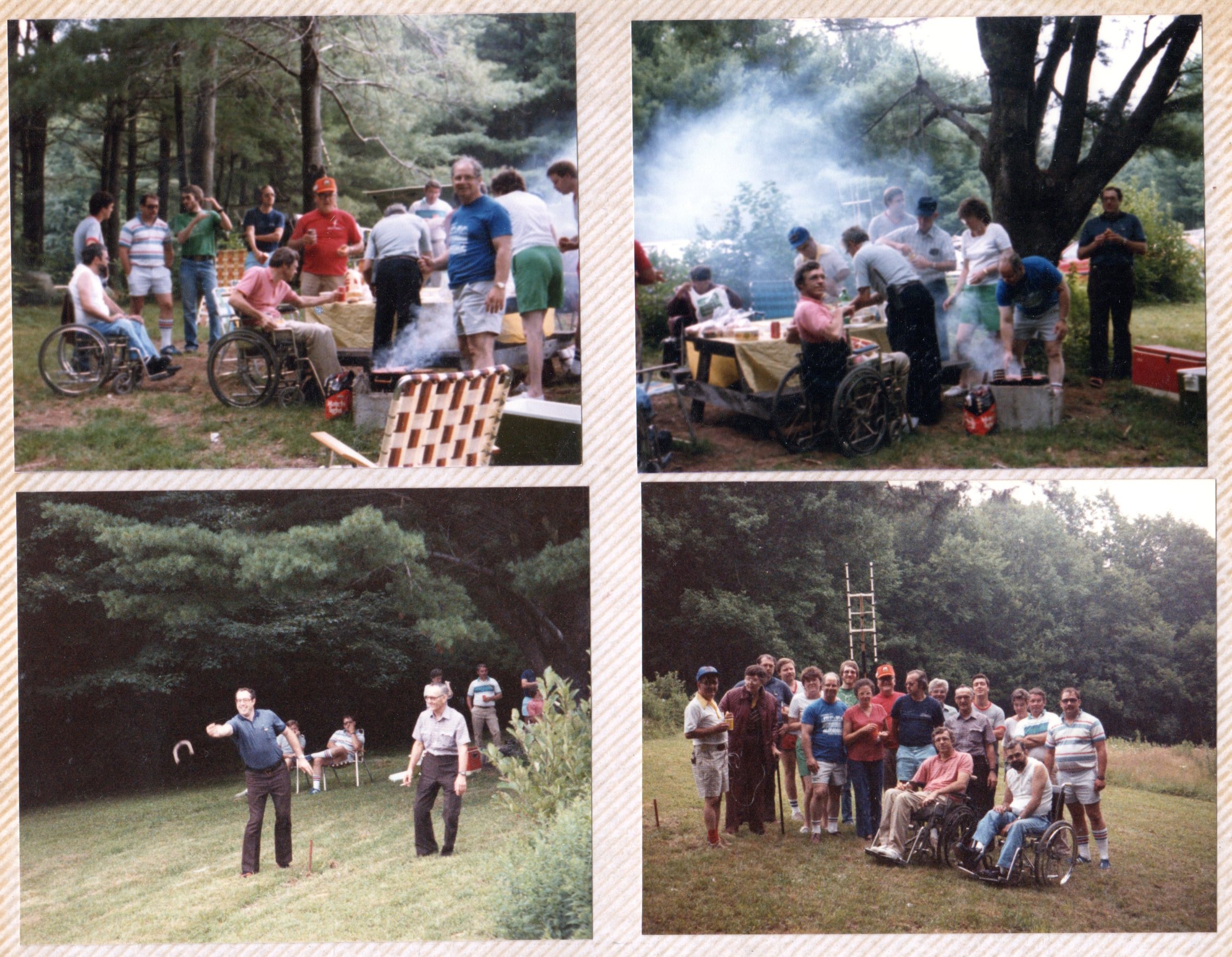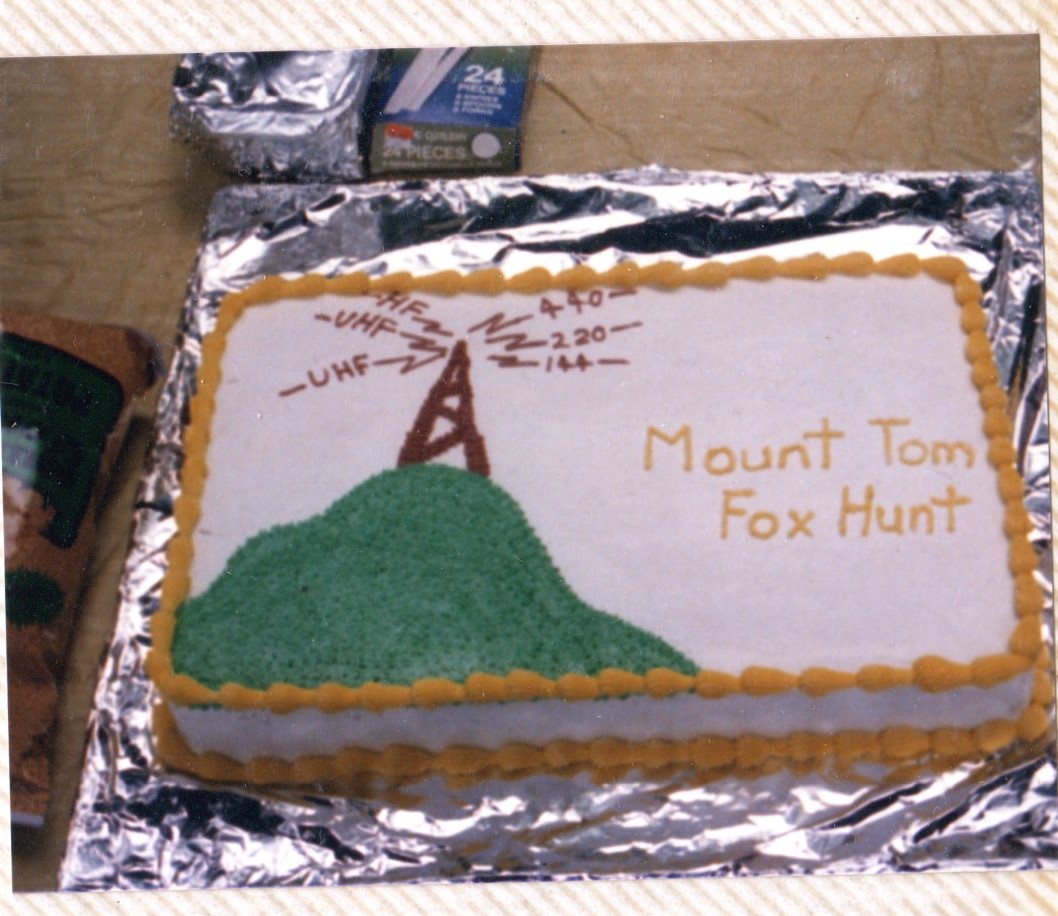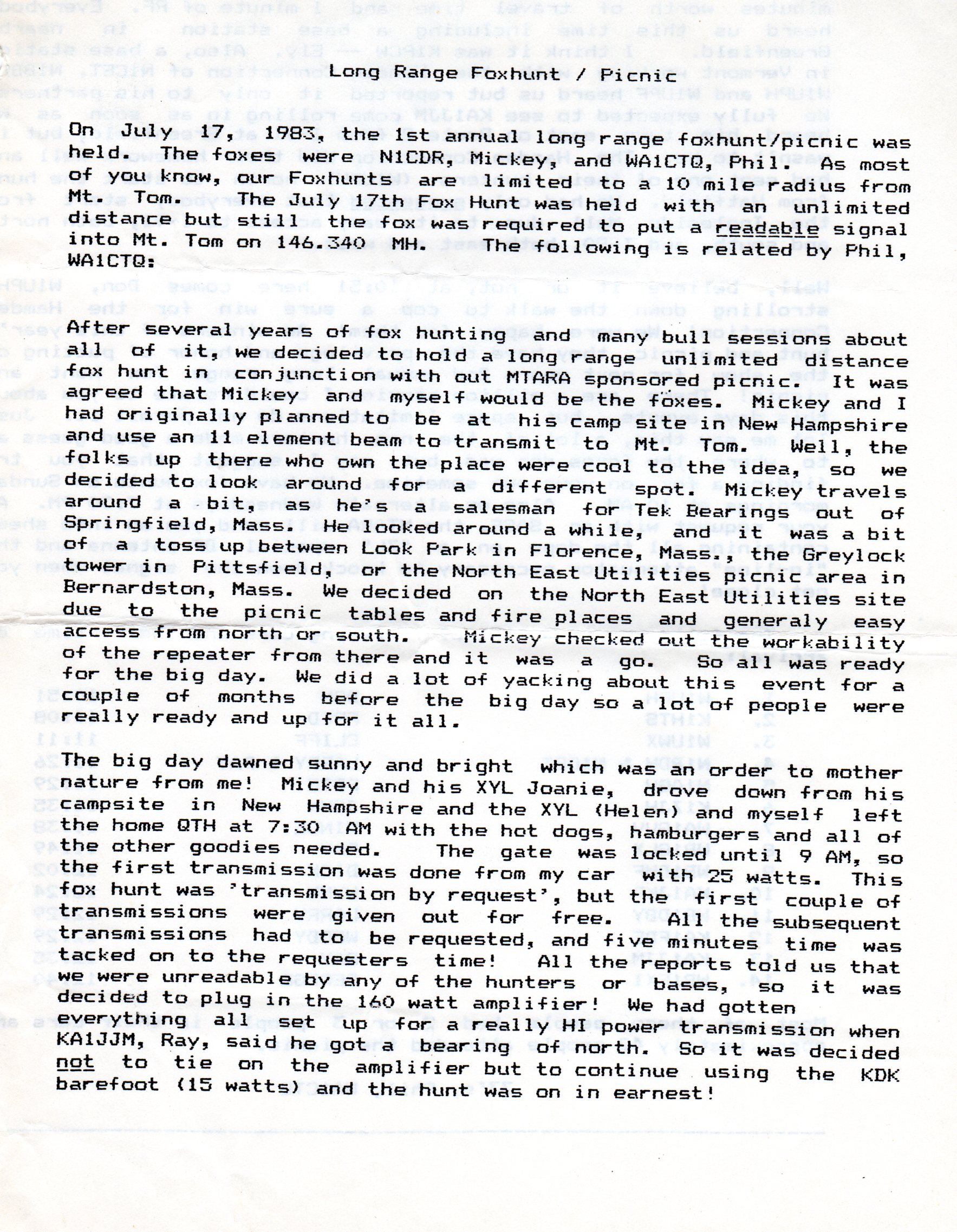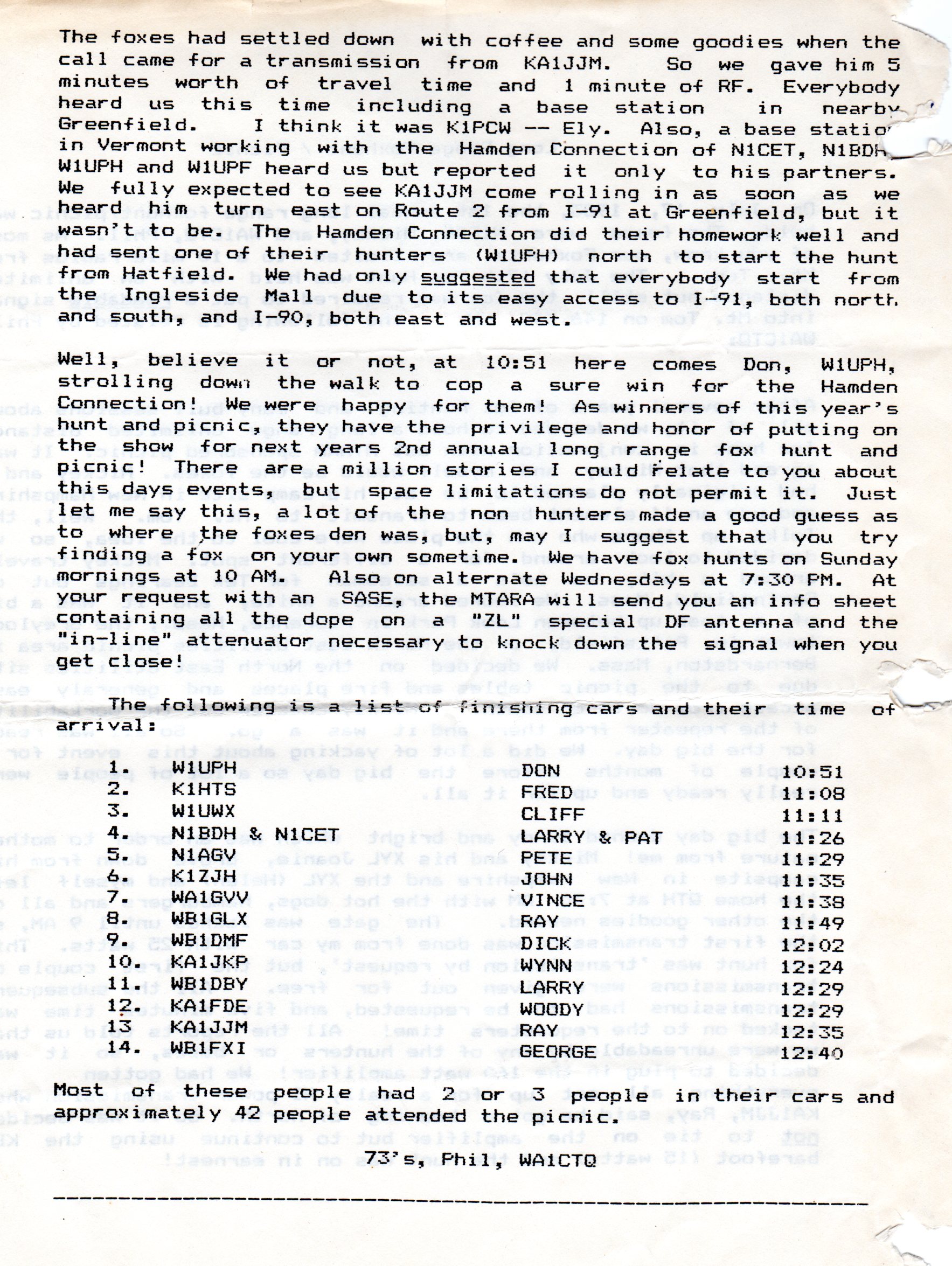The Basics on Finding the Fox
By
Larry, W1AST (ex. WB1DBY)
(with special thanks to my XYL for proof reading this)
So you want to hunt down the fox? What do you need to get started? Are there any tricks to help? What do you do? What hardware do you need? How prepared should you be?
Suggested Equipment:
-
Some sort of receiver be it a scanner, ht, mobile rig for 2 meters
You can hunt with just that, but you’ll need a LOT of luck. You also should have:
-
A directional antenna
-
receiver with a S meter to hunt with
-
2nd receiver (explained below)
-
Attenuator
-
Compass & piece of string or small rope (or 3 or more pieces of rope or string – see Steps 14 & 15)
-
Physical Map That shows Hartford, CT to Northampton, MA and everything in between (a gps just doesn’t cut it here)
-
Pad and pen
-
watch or clock
-
Co Pilot or two
The Fox will transmit one minute out of every 5 minutes. The Fox will also give a one minute warning (or try to).
Step 1: Meet other hunters at the starting point. For Sunday, November 3rds hunt, we are starting at the parking lot at the entrance to Forest park off exit 1 of route 91. This is the parking lot at Picknelly Field near the Indian and nearly into Longmeadow. It’s also across from the entrance to the King Philip Stockade. You should arrive at least 15 minutes (or more) before the hunt starts to give you time to get ready.
-
Note: Sometimes others will arrive at the starting point looking for a ride. It’s important for the hunters to have room in their vehicles for future hunters to observe (or help you).
Step 2: Have your directional antenna connected to your receiver. Verify that it is connected. Can you DF (direction find) the repeater? Does it point in the correct direction? If yes – good.
Step 3: Now tune to the input and lock it there. If you’re hunting on 94, tune your receiver to 146.34 and lock it there. Do not hunt on the 146.94 OUTPUT of the repeater (you wouldn’t be the first) otherwise you’ll end up at Mt. Tom eventually.
Step 4: Make sure your compass is in your hand or pocket (or better yet, have your co-pilot be ready with the compass, have the pad and pen near too.
Step 5: Listen for the fox to ask for check ins. Check in or ask someone else to check you in. There may be a person designated to collect everyones name and call.
Step 6: Listen for the ONE minute warning. You should be ready by then.
Step 7: When the Fox is transmitting, sweep the antenna around to the strongest signal on your S meter. Once you find it, reverse the antenna 180 degrees. Can you NULL the Fox out or greatly reduce his signal? If yes, you probably have a good heading. If you have trouble receiving the fox, sometimes moving a few feet is enough to pick up the signal better.
Step 8: Look to see where your antenna is pointed. If you are by yourself, find a spot where the antenna is pointed and remember it. Put the antenna down and use the compass to take a directional heading – looking at this spot. (or have your co-pilot do this while you aim the antenna) – Your co-pilot should stand behind the back of the antenna and point the compass down the boom of the antenna and read where it points. Reading a compass is a whole other thing – find a boy scout to help you if you can’t!
Step 9: WRITE down starting point and the heading you just took
Step 10: Open up your map and find the starting point. Put one end of the string at the starting point and using the compass, extend the string out onto the map. Look to see where it goes.
-
At this point, you could drive along the path where the string goes and some will do that. It’s up to you if you’re feeling lucky.
-
You might want to compare your headings with the other hunters
-
You might also want to listen for headings from base stations. If base stations check in, write their call and location down and their heading. (more on this further down)
Step 11: Looking at the map, find a location that is not along the string line to take your next reading. The idea here is to triangulate and find the fox. Write down that location on the pad. Put everyone and all your gear safely into your vehicle and drive to that spot you noted.
Don’t worry about missing a transmission or two by the fox. Go to the point you chose. (it takes a lot of will to not stop and swing the antenna around, try not to)
Step 12: Find a safe spot away from buildings, big trucks, maybe high up or in a clear area to take your next reading.
Step 13: Repeat steps 4 thru 8 and write down your new bearing on the pad. Don’t commit it to memory as I guarantee you’ll never remember it. Write it down.
Step 14: Plot your original heading with the string. Plot your 2nd heading with another piece of string. Do they cross? Let’s hope so. If not, take another reading OR move your location a bit and take another reading. If there are base station readings with headings, you may want to plot their headings too. Make sure it is from their QTH and not yours!
Step 15: If the lines cross, you can figure out where on the map that is and drive there OR repeat steps 3 thru 8 again from another selected spot not along the lines and plot another heading. This should give you a much more exact location where all 3 headings cross. Go there!
Step 16: So you got close, but not close enough. That’s normal. If you haven’t already, put your attenuator in line, you’re going to need it. Repeat steps 4 thru 8 again.
Now comes the exciting part – going in for the kill! It’s also where a lot of hunters get extremely frustrated – When you’re so close you can not attenuate or null out the fox anymore. How to reduce the signal strength?
You can tune your receiver OFF the exact receiving frequency by first 5 kHz then 10 kHz until the signal is reduced in strength.
If tuning with a HT, hold the HT close to your body and rotate around. IF the signal is super strong, take off the antenna. Still super strong? Open your eyes wider, you’re very close!
Be careful when getting close. Getting excited is normal, but watch out for non-hams in the area. Keep your speed down. You don’t want to get into any trouble for driving too quickly or recklessly!
If you find the fox, go up and check in with him so that your time can be recorded. Maybe you’re the first one there? If you are, don’t say anything on the repeater about being first. That’s the quickest way to discourage the other hunters.
Base Stations:
So you have a 2m beam at home? Or you hear the fox on the input? What to do?
First, those with beams. Take a good reading and also try to get a null too. Then go outside your house and take a compass reading. DO NOT rely on the rotor control heading as it could be off quite a bit. Write the heading down and then go back inside and announce your finding. Sometimes you want to listen to a few Fox transmissions to make sure your heading is good.
It’s important that base stations announce their call and name, approx cross street location or well known street and then their heading for the hunters.
Second, for those base stations without a beam. Your signal reports are just as important. Listen on the input and then announce who you are, where you are to the nearest cross street or well known street and relay how strong the fox is, whether full scale or noisy. If super loud, take off your antenna and listen again. Can you still hear the Fox? If yes, is he in your driveway? Or your neighbors?
All signal reports are important to the hunters. If you’re lucky while at home, you can take other base station readings and those of the mobile hunters and plot them on a map and announce where you think the Fox is or maybe drive there yourself.
All are welcome to the Fox’s den.
The goal is to start out the hunts easy. That means drive up, publicly accessible property without paying a fee with parking available for others. A safe location. We want lots of hunters out there and we Foxes will try to make the hunts fun, easy but challenging.
A word of warning when hiding. Sometimes the easy hunts are real hard. Sometimes the hunt you think is going to be long and difficult ends up being easy. There’s no reasoning until it’s over.
When the hunt is over and all hunters are in, or the hunt has ended, the Fox shall announce his location to the public.
Happy Hunting!
Here are some photos of some past fox hunts in the area (click image to enlarge)
